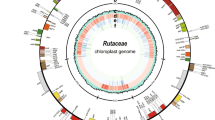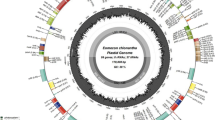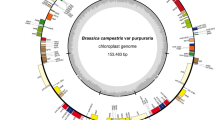Abstract
Key message
Complete plastomes of Rheum species facilitated to clarify the phylogeny of Polygonaceae, and comparative chloroplast genomics contributed to develop genetic markers for the authentication of Rheum species.
Abstract
Rheum (Polygonaceae) is widely distributed throughout the temperate and subtropical areas of Asian interior. Rheum species are usually perennial herbs, and half of them are endemic to China with important medicinal properties. On account of similar morphological characteristics, species delimitation of Rheum still remains unclear. Chloroplast genomes of eight Rheum species, Rumex crispus and Oxyria digyna were characterized. Based on the comparison of genome structure of these species and the two published Rheum species, it is shown that plastome sequences of these species are relatively conserved with the same gene order, and three Sect. Palmata species remarkably showed high sequence similarities. Some hotspots could be used to discriminate the Rheum species, and 17 plastid genes were subject to positive selection. The phylogenetic analyses indicated that all the Polygonaceae species were clustered in the same group and showed that Rheum species, except for Rheum wittrockii, formed a monophyletic group with high maximum parsimony/maximum likelihood bootstrap support values and Bayesian posterior probabilities. The molecular dating based on plastomes indicated that the divergences within Polygonaceae species were dated to the Upper Cretaceous period [73.86–77.99 million years ago (Ma)]. The divergence of Sect. Palmata species was estimated to have occurred around 1.60 Ma, indicating that its diversification was affected by the repeated climatic fluctuation in the Quaternary.






Similar content being viewed by others
References
Aldrich J, Cherney BW, Merlin E (1988) The role of insertions/deletions in the evolution of the intergenic region between psbA and trnH in the chloroplast genome. Curr Genet 14:137–146. https://doi.org/10.1007/bf00569337
Asaf S et al (2017) Comparative analysis of complete plastid genomes from wild soybean (Glycine soja) and nine other Glycine species. PLoS ONE 12:e0182281. https://doi.org/10.1371/journal.pone.0182281
Asano T, Tsudzuki T, Takahashi S, Shimada H, Kadowaki K (2004) Complete nucleotide sequence of the sugarcane (Saccharum officinarum) chloroplast genome: a comparative analysis of four monocot chloroplast genomes. DNA Res 11:93–99. https://doi.org/10.1093/dnares/11.2.93
Bankevich A et al (2012) SPAdes: a new genome assembly algorithm and its applications to single-cell sequencing. J Comput Biol 19:455–477. https://doi.org/10.1089/cmb.2012.0021
Bao B, Grabovskaya-Borodina A (2003) Rheum, vol 5. Flora of China. Science Press, Bejing
Bendich AJ (2004) Circular chloroplast chromosomes: the grand illusion. Plant Cell 16:1661–1666. https://doi.org/10.1105/tpc.160771
Benson G (1999) Tandem repeats finder: a program to analyze DNA sequences. Nucleic Acids Res 27:573. https://doi.org/10.1093/nar/27.2.573
Bouckaert R, Heled J, Kühnert D, Vaughan T, Wu CH, Xie D (2014) BEAST 2: a software platform for Bayesian evolutionary analysis. PLoS Comput Biol. https://doi.org/10.1371/journal.pcbi.1003537
Cai Z et al (2008) Extensive reorganization of the plastid genome of Trifolium subterraneum (Fabaceae) is associated with numerous repeated sequences and novel DNA insertions. J Mol Evol 67:696–704. https://doi.org/10.1007/s00239-008-9180-7
Carbonell-Caballero J, Alonso R, Ibañez V, Terol J, Talon M, Dopazo J (2015) A phylogenetic analysis of 34 chloroplast genomes elucidates the relationships between wild and domestic species within the genus Citrus. Mol Biol Evol 32:2015–2035. https://doi.org/10.1093/molbev/msv082
Caron H, Dumas S, Marque G, Messier C, Bandou E, Petit RJ, Kremer A (2000) Spatial and temporal distribution of chloroplast DNA polymorphism in a tropical tree species. Mol Ecol 9:1089–1098. https://doi.org/10.1046/j.1365-294x.2000.00970.x
Cho K-S, Yun B-K, Yoon Y-H, Hong S-Y, Mekapogu M, Kim K-H, Yang T-J (2015) Complete chloroplast genome sequence of tartary buckwheat (Fagopyrum tataricum) and comparative analysis with common buckwheat (F. esculentum). PLoS ONE 10:e0125332. https://doi.org/10.1371/journal.pone.0125332
Chinese Pharmacopoeia Committee CP (2015) Pharmacopoeia of the People's Republic of China. China Medical Science Press, Beijing
Cuénoud P, Savolainen V, Chatrou LW, Powell M, Grayer RJ, Chase MW (2002) Molecular phylogenetics of Caryophyllales based on nuclear 18S rDNA and plastid rbcL, atpB, and matK DNA sequences. Am J Bot 89:132–144. https://doi.org/10.3732/ajb.89.1.132
Davis CC, Xi Z, Mathews S (2014) Plastid phylogenomics and green plant phylogeny: almost full circle but not quite there. BMC Biol 12:11. https://doi.org/10.1186/1741-7007-12-11
Dierckxsens N, Mardulyn P, Smits G (2017) NOVOPlasty: de novo assembly of organelle genomes from whole genome data. Nucleic Acids Res 45:e18–e18. https://doi.org/10.1093/nar/gkw955
Dong W et al (2017) Phylogenetic resolution in Juglans based on complete chloroplast genomes and nuclear DNA sequences. Front Plant Sci 8:1148. https://doi.org/10.3389/fpls.2017.01148
Doyle JJ (1987) A rapid DNA isolation procedure for small quantities of fresh leaf tissue. Phytochem Bull 19:11–15
Eguiluz M, Rodrigues NF, Guzman F, Yuyama P, Margis R (2017) The chloroplast genome sequence from Eugenia uniflora, a Myrtaceae from Neotropics. Plant Syst Evol. https://doi.org/10.1007/s00606-017-1431-x
Frailey DC, Chaluvadi SR, Vaughn JN, Coatney CG, Bennetzen JL (2018) Gene loss and genome rearrangement in the plastids of five Hemiparasites in the family Orobanchaceae. BMC Plant Biol 18:30. https://doi.org/10.1186/s12870-018-1249-x
Frazer KA, Pachter L, Poliakov A, Rubin EM, Dubchak I (2004) VISTA: computational tools for comparative genomics. Nucleic Acids Res 32:W273–W279. https://doi.org/10.1093/nar/gkh458
Gao F, Chen C, Arab DA, Du Z, He Y, Ho SYW (2019) EasyCodeML: a visual tool for analysis of selection using CodeML. Ecol Evol 9:3891–3898. https://doi.org/10.1002/ece3.5015
Gruenstaeudl M, Nauheimer L, Borsch T (2017) Plastid genome structure and phylogenomics of Nymphaeales: conserved gene order and new insights into relationships. Plant Syst Evol. https://doi.org/10.1007/s00606-017-1436-5
Guo X et al (2017) Plastome phylogeny and early diversification of Brassicaceae. BMC Genomics 18:176. https://doi.org/10.1186/s12864-017-3555-3
He L, Qian J, Li X, Sun Z, Xu X, Chen S (2017) Complete chloroplast genome of medicinal plant Lonicera japonica: genome rearrangement, intron gain and loss, and implications for phylogenetic studies. Molecules 22:249. https://doi.org/10.3390/molecules22020249
Jalal A, Schwarz C, Schmitz-Linneweber C, Vallon O, Nickelsen J, Bohne A-V (2015) A small multifunctional pentatricopeptide repeat protein in the chloroplast of Chlamydomonas reinhardtii. Mol Plant 8:412–426. https://doi.org/10.1016/j.molp.2014.11.019
Kalyaanamoorthy S, Minh BQ, Wong TKF, von Haeseler A, Jermiin LS (2017) ModelFinder: fast model selection for accurate phylogenetic estimates. Nat Methods 14:587. https://doi.org/10.1038/nmeth.4285
Katoh K, Standley DM (2013) MAFFT multiple sequence alignment software version 7: improvements in performance and usability. Mol Biol Evol 30:772–780. https://doi.org/10.1093/molbev/mst010
Kikuchi S et al (2013) Uncovering the protein translocon at the chloroplast inner envelope membrane. Science 339:571–574. https://doi.org/10.1126/science.1229262
Kofer W, Koop HU, Wanner G, Steinmüller K (1998) Mutagenesis of the genes encoding subunits A, C, H, I, J and K of the plastid NAD(P)H-plastoquinone-oxidoreductase in tobacco by polyethylene glycol-mediated plastome transformation. Mol Gen Genet 258:166–173. https://doi.org/10.1007/s004380050719
Kurtz S, Choudhuri JV, Ohlebusch E, Schleiermacher C, Stoye J, Giegerich R (2001) REPuter: the manifold applications of repeat analysis on a genomic scale. Nucleic Acids Res 29:4633–4642. https://doi.org/10.1093/nar/29.22.4633
Langmead B, Salzberg SL (2012) Fast gapped-read alignment with Bowtie 2. Nat Methods 9:357–359. https://doi.org/10.1038/nmeth.1923
Leebens-Mack J et al (2005) Identifying the basal angiosperm node in chloroplast genome phylogenies: sampling one's way out of the felsenstein zone. Mol Biol Evol 22:1948–1963. https://doi.org/10.1093/molbev/msi191
Li X, Yang Y, Henry RJ, Rossetto M, Wang Y, Chen S (2015) Plant DNA barcoding: from gene to genome. Biol Rev 90:157–166. https://doi.org/10.1111/brv.12104
Li H-T et al (2019) Origin of angiosperms and the puzzle of the Jurassic gap. Nat Plants 5:461–470. https://doi.org/10.1038/s41477-019-0421-0
Lohse M, Drechsel O, Kahlau S, Bock R (2013) OrganellarGenomeDRAW—a suite of tools for generating physical maps of plastid and mitochondrial genomes and visualizing expression data sets. Nucleic Acids Res 41:W575–W581. https://doi.org/10.1093/nar/gkt289
Losina-Losinskaya A (1936) The genus Rheum and its species. Acta Instituti Botanici Academiae Scientiarum Unionis Rerum Publicarum Soveticarum Socialisticarum, Ser 1:5–141
Ma P-F, Zhang Y-X, Zeng C-X, Guo Z-H, Li D-Z (2014) Chloroplast phylogenomic analyses resolve deep-level relationships of an intractable bamboo tribe Arundinarieae (Poaceae). Systematic Biol 63:933–950. https://doi.org/10.1093/sysbio/syu054
Manchester SR, O’Leary EL (2010) Phylogenetic distribution and identification of fin-winged fruits. Bot Rev 76:1–82. https://doi.org/10.1007/s12229-010-9041-0
Nguyen L-T, Schmidt HA, von Haeseler A, Minh BQ (2015) IQ-TREE: a fast and effective stochastic algorithm for estimating maximum-likelihood phylogenies. Mol Biol Evol 32:268–274. https://doi.org/10.1093/molbev/msu300
Nguyen VB, Park H-S, Lee S-C, Lee J, Park JY, Yang T-J (2017) Authentication markers for five major Panax species developed via comparative analysis of complete chloroplast genome sequences. J Agric Food Chem 65:6298–6306. https://doi.org/10.1021/acs.jafc.7b00925
Palmer JD (1985) Comparative organization of chloroplast genomes. Annu Rev Genet 19:325–354. https://doi.org/10.1146/annurev.ge.19.120185.001545
Park I, Yang S, Kim WJ, Noh P, Lee HO, Moon BC (2018) The complete chloroplast genomes of six Ipomoea species and indel marker development for the discrimination of authentic Pharbitidis Semen (Seeds of I. nil or I. purpurea). Front Plant Sci 9:965. https://doi.org/10.3389/fpls.2018.00965
Patel RK, Jain M (2012) NGS QC Toolkit: a toolkit for quality control of next generation sequencing data. PLoS ONE 7:e30619. https://doi.org/10.1371/journal.pone.0030619
Peng L, Yamamoto H, Shikanai T (2011) Structure and biogenesis of the chloroplast NAD(P)H dehydrogenase complex. BBA-bioenergetics 1807:945–953. https://doi.org/10.1016/j.bbabio.2010.10.015
Piot A, Hackel J, Christin P-A, Besnard G (2018) One-third of the plastid genes evolved under positive selection in PACMAD grasses. Planta 247:255–266. https://doi.org/10.1007/s00425-017-2781-x
Provan J, Powell W, Hollingsworth PM (2001) Chloroplast microsatellites: new tools for studies in plant ecology and evolution. Trends Ecol Evol 16:142–147. https://doi.org/10.1016/S0169-5347(00)02097-8
Rambaut A, Drummond AJ, Xie D, Baele G, Suchard MA (2018) Posterior summarization in bayesian phylogenetics using Tracer 1.7. Syst Biol 67:901–904. https://doi.org/10.1093/sysbio/syy032
Raven JA, Allen JF (2003) Genomics and chloroplast evolution: what did cyanobacteria do for plants? Genome Biol 4:209. https://doi.org/10.1186/gb-2003-4-3-209
Ronquist F et al (2012) MrBayes 3.2: efficient Bayesian phylogenetic inference and model choice across a large model space. Syst Biol 61:539–542. https://doi.org/10.1093/sysbio/sys029
Rozas J, Ferrer-Mata A, Sánchez-DelBarrio JC, Guirao-Rico S, Librado P, Ramos-Onsins SE, Sánchez-Gracia A (2017) DnaSP 6: DNA sequence polymorphism analysis of large data sets. Mol Biol Evol 34:3299–3302. https://doi.org/10.1093/molbev/msx248
Ruhsam M et al (2015) Does complete plastid genome sequencing improve species discrimination and phylogenetic resolution in Araucaria? Mol Ecol Resour 15:1067–1078. https://doi.org/10.1111/1755-0998.12375
Saarela JM et al (2018) A 250 plastome phylogeny of the grass family (Poaceae): topological support under different data partitions. PeerJ 6:e4299. https://doi.org/10.7717/peerj.4299
Sun B-N et al (2011) Reconstructing Neogene vegetation and climates to infer tectonic uplift in western Yunnan, China. Palaeogeogr Palaeoclimatol Palaeoecol 304:328–336. https://doi.org/10.1016/j.palaeo.2010.09.023
Sun Y, Wang A, Wan D, Wang Q, Liu J (2012) Rapid radiation of Rheum (Polygonaceae) and parallel evolution of morphological traits. Mol Phylogenet Evol 63:150–158. https://doi.org/10.1016/j.ympev.2012.01.002
Swofford DL (1998) Commands used in the PAUP Block in PAUP 4.0: phylogenetic analysis using parsimony. Smithsonian Institution, Washington, DC, pp 132–135. https://doi.org/10.1007/978-1-4020-6754-9_12413
Talavera G, Castresana J (2007) Improvement of phylogenies after removing divergent and ambiguously aligned blocks from protein sequence alignments. Syst Biol 56:564–577. https://doi.org/10.1080/10635150701472164
Thiel T, Michalek W, Varshney R, Graner A (2003) Exploiting EST databases for the development and characterization of gene-derived SSR-markers in barley (Hordeum vulgare L.). Theor Appl Genet 106:411–422. https://doi.org/10.1007/s00122-002-1031-0
Timme RE, Kuehl JV, Boore JL, Jansen RK (2007) A comparative analysis of the Lactuca and Helianthus (Asteraceae) plastid genomes: identification of divergent regions and categorization of shared repeats. Am J Bot 94:302–312. https://doi.org/10.3732/ajb.94.3.302
Wang A, Liu J, Yang M (2005) Molecular phylogeny, recent radiation and evolution of gross morphology of the rhubarb genus Rheum (Polygonaceae) Inferred from chloroplast DNA trnL-F sequences. Ann Bot 96:489–498. https://doi.org/10.1093/aob/mci201
Wang X-M, Hou X-Q, Zhang Y-Q, Li Y (2014) Morphological variation in leaf dissection of Rheum palmatum complex (Polygonaceae). PLoS ONE 9:e110760. https://doi.org/10.1371/journal.pone.0110760
Wang X et al (2018a) Genetic and chemical differentiation characterizes top-geoherb and non-top-geoherb areas in the TCM herb rhubarb. Sci Rep 8:9424. https://doi.org/10.1038/s41598-018-27510-1
Wang X, Zhou T, Bai G, Zhao Y (2018b) Complete chloroplast genome sequence of Fagopyrum dibotrys: genome features, comparative analysis and phylogenetic relationships. Sci Rep 8:12379. https://doi.org/10.1038/s41598-018-30398-6
Wen J, Zhang J-Q, Nie Z-L, Zhong Y, Sun H (2014) Evolutionary diversifications of plants on the Qinghai-Tibetan Plateau. Front Genet 5:4. https://doi.org/10.3389/fgene.2014.00004
Weng M-L, Blazier JC, Govindu M, Jansen RK (2013) Reconstruction of the ancestral plastid genome in Geraniaceae reveals a correlation between genome rearrangements, repeats and nucleotide substitution rates. Mol Biol Evol 31:645–659. https://doi.org/10.1093/molbev/mst257
Wicke S et al (2013) Mechanisms of functional and physical genome reduction in photosynthetic and nonphotosynthetic parasitic plants of the broomrape family. Plant Cell 25:3711–3725. https://doi.org/10.1105/tpc.113.113373
Wicke S, Müller KF, dePamphilis CW, Quandt D, Bellot S, Schneeweiss GM (2016) Mechanistic model of evolutionary rate variation en route to a nonphotosynthetic lifestyle in plants. Proc Natl Acad Sci 113:9045–9050. https://doi.org/10.1073/pnas.1607576113
Wyman SK, Jansen RK, Boore JL (2004) Automatic annotation of organellar genomes with DOGMA. Bioinformatics 20:3252–3255. https://doi.org/10.1093/bioinformatics/bth352
Xiao PG (1981) The resource utilization of medicinal plant of Rheum. China J Chin Mat Med 6:11–13
Xue J, Wang S, Zhou S-L (2012) Polymorphic chloroplast microsatellite loci in Nelumbo (Nelumbonaceae). Am J Bot 99:e240–e244. https://doi.org/10.3732/ajb.1100547
Xu J-H, Liu Q, Hu W, Wang T, Xue Q, Messing J (2015) Dynamics of chloroplast genomes in green plants. Genomics 106:221–231. https://doi.org/10.1016/j.ygeno.2015.07.004
Yang M, Zhang D, Zheng J, Liu J (2001) Pollen morphology and its systematic and ecological significance in Rheum (Polygonaceae) from China. Nord J Bot 21:411–418. https://doi.org/10.1111/j.1756-1051.2001.tb00789.x
Yang Y, Zhou T, Duan D, Yang J, Feng L, Zhao G (2016) Comparative analysis of the complete chloroplast genomes of five Quercus species. Front Plant Sci 7:959. https://doi.org/10.3389/fpls.2016.00959
Yang Z (2007) PAML 4: phylogenetic analysis by maximum likelihood. Mol Biol Evol 24:1586–1591. https://doi.org/10.1093/molbev/msm088
Yao G et al (2019) Plastid phylogenomic insights into the evolution of Caryophyllales. Mol Phylogenet Evol 134:74–86. https://doi.org/10.1016/j.ympev.2018.12.023
Ye W-Q, Yap Z-Y, Li P, Comes HP, Qiu Y-X (2018) Plastome organization, genome-based phylogeny and evolution of plastid genes in Podophylloideae (Berberidaceae). Mol Phylogenet Evol 127:978–987. https://doi.org/10.1016/j.ympev.2018.07.001
Zhou T et al (2016) Comparative transcriptome and chloroplast genome analyses of two related Dipteronia Species. Front Plant Sci 7:1512. https://doi.org/10.3389/fpls.2016.01512
Zhou T, Wang J, Jia Y, Li W, Xu F, Wang X (2018) Comparative chloroplast genome analyses of species in Gentiana section Cruciata (Gentianaceae) and the development of authentication markers. Int J Mol Sci 19:1962. https://doi.org/10.3390/ijms19071962
Zhou T et al (2019) The complete chloroplast genome of Euphrasia regelii, pseudogenization of ndh genes and the phylogenetic relationships within Orobanchaceae. Front Genet 10:444. https://doi.org/10.3389/fgene.2019.00444
Acknowledgements
This study was supported by the National Natural Science Foundation of China (Nos. 31770364 and 81903739) and the China Postdoctoral Science Foundation (No. 2018M643680).
Author information
Authors and Affiliations
Contributions
XW and TZ conceived and designed the experiments. TZ, HZ, JW, YX, and FX performed the experiments and analyzed the data. TZ and XW wrote the paper. All authors read and approved the final manuscript.
Corresponding author
Ethics declarations
Conflict of interest
All authors did not have any conflict of interest.
Ethical approval
This article does not contain any studies with human participants or animals performed by any of the authors.
Additional information
Communicated by Rachel Wells.
Publisher's Note
Springer Nature remains neutral with regard to jurisdictional claims in published maps and institutional affiliations.
Electronic supplementary material
Below is the link to the electronic supplementary material.
299_2020_2532_MOESM1_ESM.eps
Fig. S1 Validation of IR/SC borders in Rheum species, Rumex crispus and Oxyria digyna. 1.5% agarose gels profiles of PCR fragments from 11 Rumiceae species using 4 primer pairs. Names at the top of each figures represent IR/SC regions. Abbreviated species names are shown on the top of each lanes: Rpa: Rheum palmatum, Rh: Rheum hotaoense, Rc: Rumex crispus, Ra: Rheum acuminatum, Rt: Rheum tanguticum, Ro: Rheum officinale, Od: Oxyria digyna, Rr: Rheum racemiferum, Rpr: Rheum przewalskyi, Rf: Rheum franzenbachii, Rpu: Rheum pumilum, M: DL2000 DNA ladder.
299_2020_2532_MOESM2_ESM.eps
Fig. S2 Plastome maps of 8 Rheum species, Rumex crispus and Oxyria digyna. (a) Eight Rheum chloroplast genomes, (b) Rumex crispus chloroplast genome, (c) Oxyria digyna chloroplast genome. Genes belonging to different functional groups are classified by different colors. Gray arrows indicate the direction of gene transcription. The dark gray in the inner circle indicates GC content of the plastomes
299_2020_2532_MOESM3_ESM.eps
Fig. S3 Validation of 12 molecular markers derived from hotspot regions in cp genomes. 1.5% agarose gels profiles of PCR fragments from 11 Rumiceae species using 12 primer pairs. Names at the top of each figures represent different hotspot regions. Abbreviated species names are the same as Figure S1. M: DL2000 DNA ladder
Rights and permissions
About this article
Cite this article
Zhou, T., Zhu, H., Wang, J. et al. Complete chloroplast genome sequence determination of Rheum species and comparative chloroplast genomics for the members of Rumiceae. Plant Cell Rep 39, 811–824 (2020). https://doi.org/10.1007/s00299-020-02532-0
Received:
Accepted:
Published:
Issue Date:
DOI: https://doi.org/10.1007/s00299-020-02532-0




